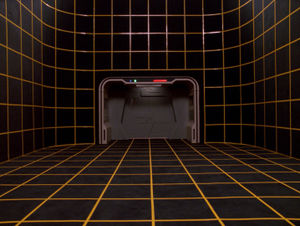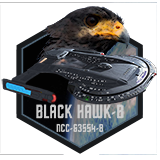More actions
Created page with "thumb|An inactive holodeck, pre-[[2371]] A '''Holographic Environment Simulator''', or '''holodeck''' for short, was a form of holotechnology desig..." |
Greenfelt22 (talk | contribs) m Text replacement - "Category:Tour" to "Category:Black Hawk Tour" |
||
| (6 intermediate revisions by 2 users not shown) | |||
| Line 1: | Line 1: | ||
[[File:Holodeck empty.jpg|thumb|An inactive holodeck, pre- | [[File:Holodeck empty.jpg|thumb|An inactive holodeck, pre-2371]] | ||
A '''Holographic Environment Simulator''', or '''holodeck''' for short, was a form of holotechnology designed and used by | A '''Holographic Environment Simulator''', or '''holodeck''' for short, was a form of holotechnology designed and used by Starfleet. They were installed aboard starships, space stations, and at Starfleet institutions for entertainment, training, and investigative purposes. A typical holodeck consisted of a room equipped with a hologrid containing omnidirectional holographic diodes, enabling holographic projections and creation of holodeck matter through the manipulation of photons contained within force fields. | ||
The Black Hawk contains 4 holodecks, Numbers 1 and 2 on Deck 6, and Numbers 3 and 4 on Deck 15. | |||
== History == | == History == | ||
Prior to the late 24th century, | Prior to the late 24th century, Federation starships were not equipped with holodecks. | ||
However, in 2151, the Starfleet vessel Enterprise NX-01 encountered a vessel belonging to an alien race known as Xyrillians, who had advanced holographic technology in the form of a holographic chamber similar to the holodeck, which | However, in 2151, the Starfleet vessel Enterprise NX-01 encountered a vessel belonging to an alien race known as Xyrillians, who had advanced holographic technology in the form of a holographic chamber similar to the holodeck, which Starfleet developed two centuries later. A holo-chamber was later installed aboard a Klingon battle cruiser, given to the Klingons by the Xyrillians (through negotiations by the ''Enterprise'' crew) in exchange for their lives. | ||
In the 23rd century, | In the 23rd century, Constitution-Class starships were equipped with a recreation room, which employed holographic technology. The USS Enterprise NCC-1701 had a recreation room located in Area 39 of the ship. | ||
By 2364, the Federation Starfleet had begun installing holodecks aboard their vessels. | By 2364, the Federation Starfleet had begun installing holodecks aboard their vessels. | ||
During the 2360s and 2370s, a starship could have one or more holodecks depending on the vessel's size or purpose. For example, compact [[Defiant- | During the 2360s and 2370s, a starship could have one or more holodecks depending on the vessel's size or purpose. For example, compact [[Defiant-Class]] starships did not have a holodeck, while the large [[Galaxy-Class]] vessels had several. | ||
== Purpose == | == Purpose == | ||
| Line 49: | Line 51: | ||
A holodeck also has the ability to create holodecks within holodecks, and holodeck programs are able to be saved to a tech cube that can be inserted into an enhancement module to form an optronic data core with information to "last a lifetime". | A holodeck also has the ability to create holodecks within holodecks, and holodeck programs are able to be saved to a tech cube that can be inserted into an enhancement module to form an optronic data core with information to "last a lifetime". | ||
{{FooterTour}} | |||
[[Category:Personnel]] [[Category:Black Hawk Tour]] | |||
Latest revision as of 12:58, 13 September 2020

A Holographic Environment Simulator, or holodeck for short, was a form of holotechnology designed and used by Starfleet. They were installed aboard starships, space stations, and at Starfleet institutions for entertainment, training, and investigative purposes. A typical holodeck consisted of a room equipped with a hologrid containing omnidirectional holographic diodes, enabling holographic projections and creation of holodeck matter through the manipulation of photons contained within force fields.
The Black Hawk contains 4 holodecks, Numbers 1 and 2 on Deck 6, and Numbers 3 and 4 on Deck 15.
History
Prior to the late 24th century, Federation starships were not equipped with holodecks.
However, in 2151, the Starfleet vessel Enterprise NX-01 encountered a vessel belonging to an alien race known as Xyrillians, who had advanced holographic technology in the form of a holographic chamber similar to the holodeck, which Starfleet developed two centuries later. A holo-chamber was later installed aboard a Klingon battle cruiser, given to the Klingons by the Xyrillians (through negotiations by the Enterprise crew) in exchange for their lives.
In the 23rd century, Constitution-Class starships were equipped with a recreation room, which employed holographic technology. The USS Enterprise NCC-1701 had a recreation room located in Area 39 of the ship.
By 2364, the Federation Starfleet had begun installing holodecks aboard their vessels.
During the 2360s and 2370s, a starship could have one or more holodecks depending on the vessel's size or purpose. For example, compact Defiant-Class starships did not have a holodeck, while the large Galaxy-Class vessels had several.
Purpose
The most obvious function of a holodeck is to provide entertainment and diversion for the crew.
A holodeck can be used to create training simulations and exercise environments not otherwise available or safe.
The holodeck can be used as a laboratory to aid in analysis, such as recreating the scene of a crime or accident to aid in forensic investigations. They can be used to visualize a 3D scene from alternate data sources for analysis, or used as a brainstorming tool. They can also be used to recreate specialized medical equipment that would rarely be needed or take up too much space in a starship's sickbay.
Design
A holodeck combines elements of transporter technology with that of replicators, by generating actual matter, as well as projecting force fields to give the objects the illusion of substance. It can be controlled from an exterior control or the interior arch control. This arch can be summoned at any time to change the parameters of a running holoprogram. Matter and energy are interchangeable as such objects created on the holodeck can be either matter or energy.
In the early 24th century, matter replication was primarily used for objects and characters that would be in direct contact with the occupants which gave them an extreme sense of realism. Water, for example, would feel like actual water because on some level, it was, and it could create experiences like odors. This also enabled simple matter to exist outside of the holodeck for brief periods of time (such as snow) before they would lose cohesion without the support of the holodeck grid and revert back to energy.
This, however, used an extreme amount of power, and caused repetitive problems to occur in its safe usage. Some time in the mid 24th century, this was slowly phased out in favor of simpler 'true' holographic technology by focusing on the photons contained within micro force fields. This was not only safer and used less power, but had more varied usage and could be easily controlled with quicker reaction times. Some would argue this made it lose its appeal, but advances in the technology has made it as real as the matter replication method, which is still used for more complex, tactile objects, as well as food, odors, etc.
Holodeck walls can generate holographic images that appear to extend for an unlimited distance, seemingly much larger than its own dimensions. In doing so, however, the holodeck is aware only of its users; it does not recognize its own created objects. For example, if a person were to throw a holographic rock at the holodeck's walls, the rock would not be allowed to pass beyond the wall (if it were of replicated matter). It does this by continuously adjusting the projections of the force fields and the use of a force field "treadmill".
With this, an individual approaching a wall causes an instant shift away. It can also manipulate light photons, 'lensing' them to make individuals appear further away if two persons were separated in a scenario. The holodeck can change gravity in three dimensions, so occupants don't notice the change, as observed during holographic orbital skydiving sessions.
Holodecks are equipped with safety protocols to prevent serious injury during their use. While active, a force field that is likely to cause a certain level of physical harm to a living humanoid collapses before making contact with them, allowing them to escape uninjured.
Holodecks employ spatial orientation systems to simulate parts of a holocharacter, such as left- or right-handedness.
Holodeck characters have been known to include a program element called a perceptual filter to hide anachronisms to the program's time period, such as uniforms and communicators, and prevent them from raising the character's ire and curiosity.
Among the viewing modes on a holodeck is objective mode, in which the user doesn't interact with the characters, and subjective mode, in which the viewer can interact with the characters as well as alter his or her surroundings.
Abilities and limitations
Holodeck matter can impersonate real matter at the molecular level. Molecule-sized magnetic bubbles replace molecules in full resolution holographic objects, which a computer can manipulate individually in three dimensions. However, the complexity of electron shell activity and atomic motions that determine biochemical activity in living creatures cannot be projected holographically. This prevents replicators from duplicating life and resurrecting the dead. Advances in computer technology may allow this, permitting a person to live forever in any chosen environment while interacting with real people and objects visiting the holodeck.
The computer may use large magnetic bubbles to simulate surfaces and textures rather than create an object at the molecular level. However, objects created within the holodeck would not exist beyond the holodeck itself, as they only exist as energy. Since holodeck technology can be used with replicator technology, there are some instances where real objects are replicated within the holodeck and are used to interact with the holographic program and/or users; since these objects are real material composed of matter, they can leave the holodeck fully intact.
Holograms can be augmented with force beams to simulate solid, tangible objects or with replicator technology to create actual solid matter such as foodstuffs. All food eaten on the holodeck are replications. No other type of simulation would survive outside of the holodeck.
A holodeck also has the ability to create holodecks within holodecks, and holodeck programs are able to be saved to a tech cube that can be inserted into an enhancement module to form an optronic data core with information to "last a lifetime".
| USS BLACK HAWK TOUR • COMPLETE DECK LISTING | |
| KEY LOCATIONS | Main Bridge • Main Conference Lounge • Sickbay • Flight Deck • Main Engineering • Security Complex |
| SECONDARY LOCATIONS | Captain's Ready Room • XO's Ready Room • Brig • Armory • Mess Hall • Cargo Bays • Transporter Room Science Labs • Auxiliary Control • Chief Counselor's Office • Chief Operations Officer's Office Squadron Command Center • Intelligence Center |
| LIVING AREAS | Captain's Quarters • Senior Officer Quarters • Officer Quarters • Junior Officer Quarters Senior NCO Quarters • NCO Quarters • Enlisted Quarters VIP / Guest / Civilian Quarters • Fighter Pilot Quarters |
| OFF DUTY & LOUNGE | Holosuites • Holodecks • Talons • USS Black Hawk War Time Memorial • Recreation Room • Library • Arboretum |
